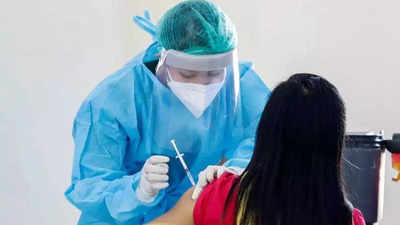- News
- City News
- ahmedabad News
- 81% stayed on schedule for second vaccine shot in Gujarat
Trending
This story is from December 8, 2021
81% stayed on schedule for second vaccine shot in Gujarat
In the past 50 days, the share of those vaccinated for the first dose of Covid vaccine rose from 90% to 94% — recording 4% rise. In comparison, those who got the second shot rose from 48% to 76% — recording 28% rise. In all, for every first shot administered, the state administered seven second shots during the period.

Picture used for representational purpose only
AHMEDABAD: In the past 50 days, the share of those vaccinated for the first dose of Covid vaccine rose from 90% to 94% — recording 4% rise.
In comparison, those who got the second shot rose from 48% to 76% — recording 28% rise. In all, for every first shot administered, the state administered seven second shots during the period.
“About 81% of those who have got the first shot have adhered to the schedule and have got the second shot,” said a senior state health department official.“State-wide campaign is on by various authorities including incentivizing the vaccination and calling up those who are due for their second shot. In some areas, door-to-door vaccination has also been initiated.”
However, analysis of district-wise status reveal that Botad has the lowest compliance of first dose at 69% of eligible 5.62 lakh population, followed by Patan (74%) and Amreli (75%) – all three have less than 20% of state average. Likewise, Dang (46%) and Botad (60%) have 20% lesser second dose coverage than the state average.
In comparison, those who got the second shot rose from 48% to 76% — recording 28% rise. In all, for every first shot administered, the state administered seven second shots during the period.
“About 81% of those who have got the first shot have adhered to the schedule and have got the second shot,” said a senior state health department official.“State-wide campaign is on by various authorities including incentivizing the vaccination and calling up those who are due for their second shot. In some areas, door-to-door vaccination has also been initiated.”
However, analysis of district-wise status reveal that Botad has the lowest compliance of first dose at 69% of eligible 5.62 lakh population, followed by Patan (74%) and Amreli (75%) – all three have less than 20% of state average. Likewise, Dang (46%) and Botad (60%) have 20% lesser second dose coverage than the state average.
Among cities, Ahmedabad has reached 99% coverage of first dose whereas Bhavnagar, Gandhinagar, Junagadh, Rajkot, Surat and Vadodara have recorded 100% coverage. Gandhinagar has highest coverage of second dose at 88% and Ahmedabad has lowest 66% coverage. All other cities have 75% to 85% coverage.
End of Article
FOLLOW US ON SOCIAL MEDIA











